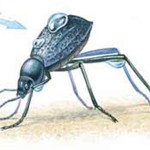Namib beetle
Vertical Windblown water (blue arrow) becomes a drink for a carefully positioned Namib Desert beetle. Facing into the breeze, with its body angled at forty-five degrees, the beetle catches fog droplets on its hardened wings. The droplets stick there to hydrophilic bumps, which are surrounded by waxy, hydrophobic troughs. Droplets accumulate and coalesce until their combined weight overcomes the water's attraction to the bumps as well as any opposing force of the wind; in a ten-mile-an-hour breeze, such a droplet would stick to the wing until it grows to roughly two-tenths of an inch in diameter; at that point it would roll down the beetle's back to its mouth parts, quenching a desert thirst. Roberto Osti | Horizontal Windblown water (blue arrow) becomes a drink for a carefully positioned Namib Desert beetle. Facing into the breeze, with its body angled at forty-five degrees, the beetle catches fog droplets on its hardened wings. The droplets stick there to hydrophilic bumps, which are surrounded by waxy, hydrophobic troughs. Droplets accumulate and coalesce until their combined weight overcomes the water's attraction to the bumps as well as any opposing force of the wind; in a ten-mile-an-hour breeze, such a droplet would stick to the wing until it grows to roughly two-tenths of an inch in diameter; at that point it would roll down the beetle's back to its mouth parts, quenching a desert thirst. Roberto Osti | Thumb Windblown water (blue arrow) becomes a drink for a carefully positioned Namib Desert beetle. Facing into the breeze, with its body angled at forty-five degrees, the beetle catches fog droplets on its hardened wings. The droplets stick there to hydrophilic bumps, which are surrounded by waxy, hydrophobic troughs. Droplets accumulate and coalesce until their combined weight overcomes the water's attraction to the bumps as well as any opposing force of the wind; in a ten-mile-an-hour breeze, such a droplet would stick to the wing until it grows to roughly two-tenths of an inch in diameter; at that point it would roll down the beetle's back to its mouth parts, quenching a desert thirst. Roberto Osti |